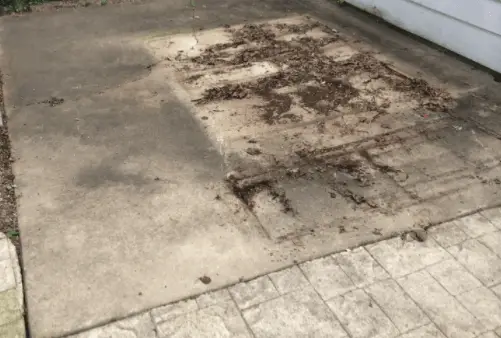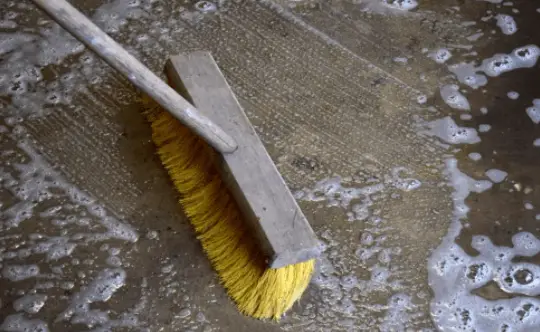Hardscapes beautify the exterior of our homes, prevents soil erosion and create you a place for parking, walking and even somewhere to relax or have fun. Hardscapes are also durable and will serve you for decades to come.
Harsh weather elements and heavy usage typically takes a toll in your patios, driveways and sidewalks. This makes them to lose their lustrous looks if not well cared for. A nice regular cleaning is all it takes to restore and maintain your outdoor surfaces.

Thorough patio cleaning is mostly done once or twice per year especially during spring to remove winter mud and grime, a rinse after a barbecue is necessary to remove the food stains.
Besides making your concrete floors to look dull. Dirt on your patio will also attract weeds and fungi such as mold which are dangerous when they grow in a home and at the same time difficult to get rid of them.
what to use for Cleaning a Concrete Patio Floor
The method you use for cleaning your patio will depend on how heavily stained or soiled it is. A mild soap or vinegar solution, hose and a stiff broom are what most people use to clean hardscapes.
Heavily soiled or stained patio will need a pressure washer machine for a fast and effortless cleaning. But the machine requires a skill to prevent damaging your surfaces.
Patios in humid areas badly suffer mold and algae infestations and a household cleaner such as vinegar, baking soda or bleach may be used for cleaning the fungus. Concrete patios should be kept dry to prevent future growth of mold, algae or moss.
When using bleach or vinegar to clean your outdoor areas, it is good to be aware that these household chemicals has a potential to kill plants and weeds. Bleach specifically can also be harmful to other living organisms including yourself.
Why not use a Pressure Washer on your Patios
Most people resolve to use a pressure washer to tackle tough dirt on hardscapes and motor oil stains on driveways. Although a popular and fast way of cleaning paving stone, bricks or concrete, a power washer can wreak havoc on these outdoor surfaces.
A pressure washer becomes a threat when the operator don’t have the skills to use the machine correctly. Most people who purchase or hire a pressure washer think that, there is no skill required to turn on the machine, aim and pull the trigger.
Incorrect use of a power washer to clean hardscapes is highly likely to cause a significant conspicuous damage. There will be some sort of pitting lines and sometimes surface degradation will take place. Further, a blast of water can damage the mortar between the brick as the joint sand is also washed away.
There are many horror stories of a pressure washer stripping paint off houses, destroying wood decks, damaging car paint jobs, ripping off siding and shingles, and even causing serious injuries to the operator.
Using a pressure washer has to begin by choosing the right nozzle, set to a standard pressure level as instructed and avoid holding the wand too close to the surface or directing the jet at one spot for too long.
In particular, avoid using a pressure washer especially when you have no idea on how to use it. Although damaged concrete can be repaired, sand be replenished and bricks be replaced, it is costly affair and it will also change the original looks of your surfaces.
How to Clean Concrete Patio without Pressure Washer

Perfect regular sweeping of your paving stone patio, walkways or driveways. To avoid using a pressure washer, regularly clean loose dirt and debris on hardscape with a broom or a garden hose.
To easily remove sticky dirt and grime, soak the surface with a gentle soap and gently scrub using a soft-bristle brush or broom. Hose to remove the residue. If you stick to your cleaning routine, you will notice that, using a pressure washer or chemical cleaner will not be that necessary.
Sometimes where there are stains, grime and fungal growth, you may resolve to use of commercial cleaners, that are potentially harmful to your surfaces, neighboring plants or pets. Vinegar, baking soda or diluted bleach can be great options for dealing with serious stains and sticky dirt.
Cleaning patio with Vinegar
Vinegar is a natural cleaner that is safe to use for cleaning of your surfaces. Mix white vinegar and water in equal parts and apply on the stains. Let it sit for 10 minutes then scrub the heavily soiled patios using a hard bristle broom.
If the stain is not getting off, spray it with undiluted vinegar and leave it to stay for 10 minutes before you scrub again. Use a hose to wash away the cleaner and dirt debris.
Baking soda
Baking soda is also a remedy for soiled hardscapes. Mix ½ cup of baking soda with a gallon of water. To make the solution more effective, add 1/8 cup of liquid dish washing detergent. Spray it on the stains or entire surface and let it sit for 20 minutes. Follow with a scrub and a rinse using a garden hose.
Cleaning Concrete Patio with Bleach
Bleach should be the last resort especially when you are dealing with tough stains or sticky grime. Remember safety first – use away from children and pets. Put on gloves and gas mask to avoid inhaling bleach. Mix bleach with water and in equal parts and put the solution in a spray bottle.
Spray bleach solution on the stained surface and let it sit for 10 minutes. Don’t spray a lot such that it begins to overflow to adjacent flowers or grass. Use a deck brush to scrub off stains and rinse the solution using a garden hose.
Bleach is also effective in getting rid of mold on pavers and patio stones. The solution kills many weeds and some plants. Use with cautious to avoid affecting wanted plants.
After cleaning your brick or concrete patio, let it dry before you return furniture and other objects. Dampness attracts the growth of mold and sea weeds such as green algae and moss on patio stones. If there is no direct sunlight on the surface, find a way of driving away any moisture left behind.